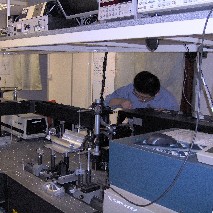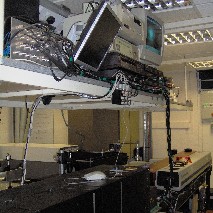

World Wide Welfare:
high BRIGHTness
semiconductor lasER for
gEneric Use
high BRIGHTness
semiconductor lasER for
gEneric Use
Partner 23 - University of Nottingham
The Photonic and Radio Frequency Engineering Group (PRFEG) in the School of Electrical and Electronic Engineering pursues cutting edge research in photonics and microwave technology. PRFEG researchers have come together from a wide range of cultural backgrounds to create a dynamic and enthusiastic research environment. The group’s activities are organised along three strands, funded by the EC, EPSRC and industry.
The activities of the High-Power Optoelectronics research strand, established 12 years ago, have contributed to the European high-power laser diode projects WWW.BRIGHT.EU, ULTRABRIGHT, POWERPACK and NODELASE. The strand’s activities focus on:
a) the design and modelling of high-power and high-brightness lasers;
b) reliability and degradation studies of laser diodes;
c) the development of novel high-brightness laser diodes.
The Group has successfully developed 2.5D & 3D coupled models (i.e. optical, electronic & thermal), including a multi-wavelength “spectral” model for the predictive design and simulation of laser diodes. Advanced models for gain dynamics and thermal effects in laser diodes have also been developed. Over a number of years, we have developed a flexible, state-of-the-art facility for characterising optoelectronic materials and devices (OMES).
The activities of the Photonic Communications Technology research strand are focused on studying devices, physical effects and materials that will, over the next decade, have a major impact on communications infrastructure. These include gain dynamics and non-linear optical effects in SOAs for wavelength conversion and functional photonics, novel optical materials and optical power budget/amplification in photonic integrated circuits.
A particular emphasis is given to optical sampling using SOA-based four wave mixing for pulse characterisation and BER estimation. Optical regeneration technologies and optical performance monitoring techniques are also being investigated. A further activity is looking at the non-linear effects of components in optical network / system contexts including the transmission of rf signals over fibre.
The RF Devices, Circuits and Materials research strand activities grew out of a close interaction with the School of Physics. The activities are more oriented towards the interaction of microwaves with materials in general as well as the design of microwave integrated circuits for material assessment applications.
In collaboration with the applied optics group, we are investigating active pixel circuits operating above 1 GHz. Devices for microwave power and millimetre waves are being actively investigated. The strand is benefiting from the purchase of a new vector network analyser that will allow the characterization of active and passive rf devices and circuits to 330 GHz.
PRFEG belongs to the University of Nottingham Institute of Materials (UNIMAT) and plays a leading role in the UNIMAT Interdisciplinary Doctoral Training Centre (IDTC) for Photonics and Electronics, which is funded by the University to stimulate interdisciplinary research and training between the Schools of Electrical and Electronic Engineering, Physics, Chemistry, Mechanical, Materials & Manufacturing Engineering, Pharmacy, and the Medical Sciences.
The activities of the High-Power Optoelectronics research strand, established 12 years ago, have contributed to the European high-power laser diode projects WWW.BRIGHT.EU, ULTRABRIGHT, POWERPACK and NODELASE. The strand’s activities focus on:
a) the design and modelling of high-power and high-brightness lasers;
b) reliability and degradation studies of laser diodes;
c) the development of novel high-brightness laser diodes.
The Group has successfully developed 2.5D & 3D coupled models (i.e. optical, electronic & thermal), including a multi-wavelength “spectral” model for the predictive design and simulation of laser diodes. Advanced models for gain dynamics and thermal effects in laser diodes have also been developed. Over a number of years, we have developed a flexible, state-of-the-art facility for characterising optoelectronic materials and devices (OMES).
The activities of the Photonic Communications Technology research strand are focused on studying devices, physical effects and materials that will, over the next decade, have a major impact on communications infrastructure. These include gain dynamics and non-linear optical effects in SOAs for wavelength conversion and functional photonics, novel optical materials and optical power budget/amplification in photonic integrated circuits.
A particular emphasis is given to optical sampling using SOA-based four wave mixing for pulse characterisation and BER estimation. Optical regeneration technologies and optical performance monitoring techniques are also being investigated. A further activity is looking at the non-linear effects of components in optical network / system contexts including the transmission of rf signals over fibre.
The RF Devices, Circuits and Materials research strand activities grew out of a close interaction with the School of Physics. The activities are more oriented towards the interaction of microwaves with materials in general as well as the design of microwave integrated circuits for material assessment applications.
In collaboration with the applied optics group, we are investigating active pixel circuits operating above 1 GHz. Devices for microwave power and millimetre waves are being actively investigated. The strand is benefiting from the purchase of a new vector network analyser that will allow the characterization of active and passive rf devices and circuits to 330 GHz.
PRFEG belongs to the University of Nottingham Institute of Materials (UNIMAT) and plays a leading role in the UNIMAT Interdisciplinary Doctoral Training Centre (IDTC) for Photonics and Electronics, which is funded by the University to stimulate interdisciplinary research and training between the Schools of Electrical and Electronic Engineering, Physics, Chemistry, Mechanical, Materials & Manufacturing Engineering, Pharmacy, and the Medical Sciences.
Activities within WWW.BRIGHT-EU
Within the project, the University of Nottingham (UNott) is contributing in the areas of laser diode simulation and design, advanced characterisation and reliability studies.
UNott is further developing their spectral laser simulation tool to include the capability to simulate high-brightness external cavity laser diodes and phase-coupled mini arrays. UNott is also working on the simulation and design optimisation of tapered lasers with split contacts at 1060 nm for display applications.
UNott will perform intracavity electroluminescence imaging measurements on tapered lasers, which will be used for advanced validation of the spectral laser simulation tool. UNott is also using the by-emitter degradation analysis method to look at bar-level degradation processes due to thermal, electrical and mechanical interactions between emitters in both red-emitting laser bars and laser bars mounted on different heatsink technologies. The existence of near- and mid-infrared defects in near-infrared laser diodes will be investigated by the Max-Born-Institute and UNott.
Finally, UNott are responsible for co-ordinating the WWW.BRIGHTER.EU training, dissemination and popularisation activities.
Within the project, the University of Nottingham (UNott) is contributing in the areas of laser diode simulation and design, advanced characterisation and reliability studies.
UNott is further developing their spectral laser simulation tool to include the capability to simulate high-brightness external cavity laser diodes and phase-coupled mini arrays. UNott is also working on the simulation and design optimisation of tapered lasers with split contacts at 1060 nm for display applications.
UNott will perform intracavity electroluminescence imaging measurements on tapered lasers, which will be used for advanced validation of the spectral laser simulation tool. UNott is also using the by-emitter degradation analysis method to look at bar-level degradation processes due to thermal, electrical and mechanical interactions between emitters in both red-emitting laser bars and laser bars mounted on different heatsink technologies. The existence of near- and mid-infrared defects in near-infrared laser diodes will be investigated by the Max-Born-Institute and UNott.
Finally, UNott are responsible for co-ordinating the WWW.BRIGHTER.EU training, dissemination and popularisation activities.
Further Information
Further information can be obtained from:
Prof. Eric Larkins
Tel: +44 115 951 5534
Email: eric.larkins@nottingham.ac.uk
Web: http://hermes.eee.nott.ac.uk/prfeg
Further information can be obtained from:
Prof. Eric Larkins
Tel: +44 115 951 5534
Email: eric.larkins@nottingham.ac.uk
Web: http://hermes.eee.nott.ac.uk/prfeg


[Home] [Project] [Participants] [Newsletters] [Publications] [Workshops] [Tutorials] [More...] [Private] [Legal notice]
